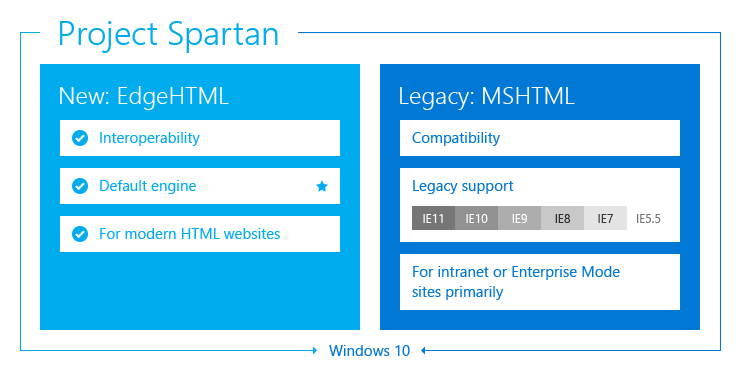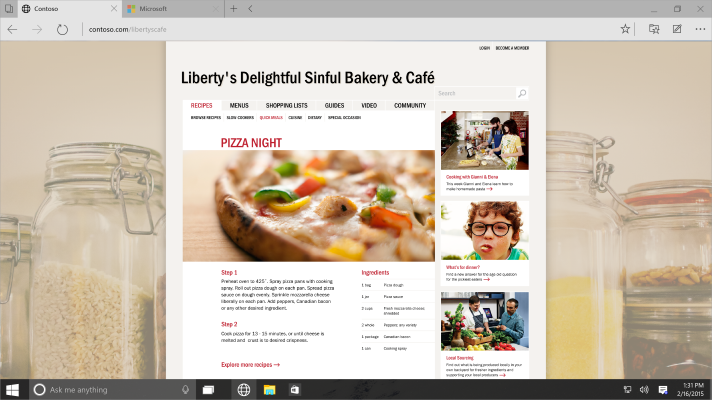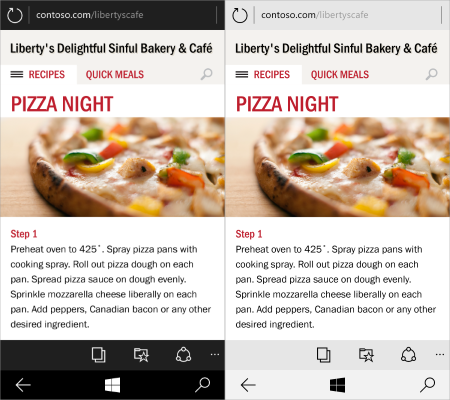After unveiling its new Project Spartan browser for Windows 10 yesterday, Microsoft today offered more details. The company confirmed that Windows 10 will also include Internet Explorer for enterprise sites, though it didn’t say how exactly this will work.
Spartan comes with a new rendering engine, which doesn’t rely on the versioned document modes the company has historically used. It also provides compatibility with the millions of existing enterprise websites specifically designed for Internet Explorer by loading the IE11 engine when needed. In this way, the browser uses the new rendering engine for modern websites and the old one for legacy purposes.
That said, Microsoft also includes this note:
We recognize some enterprises have legacy websites that use older technologies designed only for Internet Explorer, such as custom ActiveX controls and Browser Helper Objects. For these users, Internet Explorer will also be available on Windows 10. Internet Explorer will use the same dual rendering engines as Spartan, ensuring web developers can consistently target the latest web standards.
The wording seems to imply that enterprise customers will be able to obtain a copy of Windows 10 that specifically comes with Internet Explorer, something we saw a hint of yesterday. If that’s true, most users will never see Internet Explorer in Windows 10: The IE11 rendering engine may be there, but only the Project Spartan browser (whatever it ends up being called) will be available.
Microsoft doesn’t explicitly say that (when we got in touch, the company declined to comment on how IE will show up in Windows 10), but this would make a lot more sense than shipping two browsers, especially if one is familiar and one is “new.” Spartan will feature the ability to annotate web pages, a distraction-free reading mode, and integration with Cortana for “finding and doing things online faster.”
Spartan is also supposed to offer better input features; in addition to keyboard and mouse, it will work with touch, gestures, voice, controllers, and sensors. Oh, and since Windows 10 will work on all sorts of devices, from PCs to smartphones, so will Spartan:
Like Windows 10, Microsoft is promising Spartan will be regularly updated with new platform capabilities, security and performance improvements, and web development tweaks. Unfortunately, Project Spartan isn’t yet ready for a public preview, and it won’t be available in the next Windows 10 build coming to testers next week.
That build will, however, include updates to the new rendering engine that Spartan will use. A portion of testers were given an earlier version of the rendering engine via the Windows Technical Preview in November, and Microsoft says it has received over 12,000 feedback reports since then. The new build has over 2,000 changes, which the company says is largely influenced by that feedback.
In addition to fixes, Microsoft is promising the following new features for the engine:
- HTTP Strict Transport Security (HSTS) — an HTTP header to inform the browser to always request a given domain over SSL, reducing MITM attack surface area.
- HTTP Live Streaming (HLS) and Dynamic Adaptive Streaming over HTTP (DASH) — expands our plugin-free adaptive video streaming to support the popular HLS and DASH protocols.
- Video Tracks — adds the ability to get information about multiple video tracks, and switch between them using the VideoTrack.selected attributes.
- DOM L3 XPath — initial support for accessing the DOM tree using the XPath syntax. Expanded support will come in a future release.
Microsoft also plans to increase the number of testers who get the new engine, but stopped short of sharing when it will be the default for all users. If you can’t wait, you can opt-in yourself on Windows 10 by navigating to about:flags and setting “Enable Experimental Web Platform Features” to Enabled.





